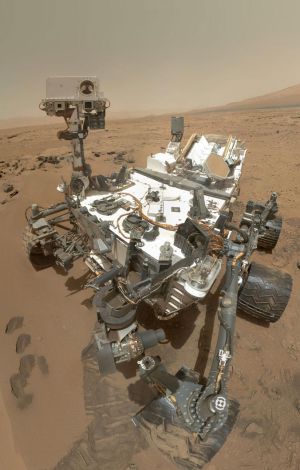
The ‘curiosity’ in a ‘selfie’ robot, which was taken at high resolution. / NASA
In its way the desolate lands of Mars, the robot Curiosity has encountered an enigma for now can not solve. So far there had been no major problems to show that this planet was habitable, that radiation does not pose an insurmountable barrier for future human or removing water vapor from the sands of world missions. Now one of its scientific instruments detected a source of methane that appears and disappears without explanation. On Earth, 90% of all methane in the atmosphere is produced by living things. Capture this gas on the Red Planet could point to the presence of life today, although there are other possible explanations. For now there is only one thing clear, something is causing methane levels multiply up to ten and then back down sharply, as explained today in Science scientists Curiosity , including two Spanish researchers.
So far most surprising of this mission was that it had not detected the gas. Preliminary observations made from Earth and probes launched by Europe and the US had caught his presence. According to these observations, methane on Mars seemed to come and go, increase locally at some points depending on the time of year. But those levels were inconsistent with the lifetime of methane, which should remain in the atmosphere for about 300 years, so the scientific soundness of these tests has been questioned
The data have been published with the greatest of asepsis, but recognize the possibility that captured methane has a biological origin
New data from the Curiosity at ground can settle the matter: there methane on Mars. The study compiles 20 months of data during which the robot’s largest and most expensive exploration of history has traveled the Gale, a crater more than 150 kilometers in diameter near the Martian Ecuador was chosen as a destination for its potential to find new clues about whether life existed on this planet. In this environment , Curiosity registered with the instrument SAM surges gas levels in Gale. These show that the base values are lower than thought, just 0.7 parts per billion by volume (ppmv), but significantly increased six times, one sometimes exceed seven ppmv, 10 times. This indicates that there is “an additional source of methane of unknown origin,” the team’s mission in his studio.
The data have been published with the greatest of asepsis not to raise false hopes, but recognize the possibility that the captured methane has a biological origin. The degradation of fallen meteorites on the planet, comet impacts or release from ancient deposits are other possible explanations.
“Our measurements during one Martian year indicate that they are generating small amounts of methane over a mechanism or combination of mechanisms, “says Javier Martin-Torres, co-author of the study and researcher at the Andalusian Institute of Earth Sciences (CSIC-UGR). “I’d bet on a geological origin, but obviously is no scientific evidence” points out.
Martin-Torres is responsible scientist REMS instrument aboard the Curiosity , which functions as the weather station mission. The research highlights the importance of this instrument developed in Spain has had to find out if methane levels are related to temperature, humidity, radiation, etc. “It was not until we had a Martian measures we could take advantage of the usefulness of measures of REMS to study seasonal patterns of environmental variables and understand their variations in a special environment such as Gale Crater year,” he emphasized.
Organic Compounds
“In my opinion, these data fit more with a biological model,” says Ricardo Amils, researcher at the Centre for Astrobiology. “The possibility of present life on Mars is again on the table,” says the researcher, who believes himself Curiosity can add more data on the origin of methane analyzing the composition of isotopes in the gas.
The robot NASA has also found signs of organic compounds on the surface of Mars. Usually made of carbon and hydrogen, come from a rock called Cumberland where Curiosity applied a drill to analyze its composition. This is the first time that these compounds are detected in the Martian soil, but for now you can not tell if they occurred on Mars itself, or whether they came aboard a meteorite. It is also unclear what compounds is because the analysis process with the SAM instrument itself transforms.
This type of compounds are the building blocks of life, although they may be present with no life the planet, NASA explained in a press release. “We will continue investigating the enigmas posed by these findings,” said John Grotzinger, one of the scientists leading the mission. To do this, one of the first things you will do the Curiosity will “do more holes” in Martian rocks, said Grotzinger, while the vehicle ascends the slopes of the mountain in between Gale Crater and has about 5,000 meters high.
No comments:
Post a Comment